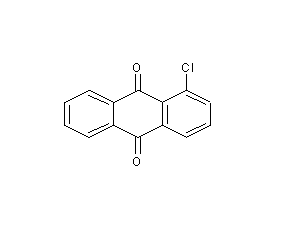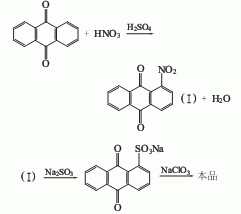1-chloroanthraquinone

Structural formula
| Business number | 01SX |
|---|---|
| Molecular formula | C14H7ClO2 |
| Molecular weight | 242.66 |
| label |
1-chloroanthraquinone, α-Chloroanthraquinone, α-chloroanthraquinone, Aromatic aldehydes, ketones and their derivatives |
Numbering system
CAS number:82-44-0
MDL number:MFCD00001189
EINECS number:201-421-4
RTECS number:CB6150000
BRN number:1912752
PubChem number:24892317
Physical property data
1. Properties: yellow needle crystal, industrial product is light yellow powder.
2. Density (g/mL, 25/4℃): Uncertain
3. Relative vapor density (g/mL, air=1): Uncertain
4. Melting point (ºC): 162
5. Boiling point (ºC, normal pressure): Uncertain
6. Boiling point (ºC, 5.2kPa): Uncertain
7. Refractive index: Uncertain
8. Flash point (ºC): Uncertain
9. Specific rotation (º): Uncertain
10. Autoignition point or ignition temperature (ºC): Uncertain
11. Vapor pressure (kPa, 25ºC): Uncertain
12. Saturated vapor Pressure (kPa, 60ºC): Uncertain
13. Heat of combustion (KJ/mol): Uncertain
14. Critical temperature (ºC): Uncertain
15. Critical pressure (KPa): Uncertain
16. Log value of oil-water (octanol/water) partition coefficient: Uncertain
17. Explosion upper limit (%, V/V): Uncertain
18. Lower explosion limit (%, V/V): Uncertain
19. Solubility: Soluble in acetic acid, nitrobenzene, amyl alcohol and Hot benzene, slightly soluble in hot ethanol, insoluble in water. It is gray-yellow in concentrated sulfuric acid.
Toxicological data
1. Acute toxicity:
Mouse intravenous LD50: 56 mg/kg;
2. Neurotoxicity: Rabbit eye test: 500 mg/24HREACTION;
Ecological data
None
Molecular structure data
1. Molar refractive index: 63.56
2. Molar volume (cm3/mol): 171.0
3. Isotonic specific volume (90.2K ): 471.9
4. Surface tension (dyne/cm): 58.0
5. Polarizability (10-24cm3):25.19
Compute chemical data
1. Reference value for hydrophobic parameter calculation (XlogP): None
2. Number of hydrogen bond donors: 0
3. Number of hydrogen bond acceptors: 2
4. Number of rotatable chemical bonds: 0
5. Number of tautomersAmount: None
6. Topological molecule polar surface area 34.1
7. Number of heavy atoms: 17
8. Surface charge: 0
9. Complexity: 352
10. Number of isotope atoms: 0
11. Determine the number of atomic stereocenters: 0
12. Uncertain Number of atomic stereocenters: 0
13. Determined number of stereocenters of chemical bonds: 0
14. Uncertain number of stereocenters of chemical bonds: 0
15 .Number of covalent bond units: 1
Properties and stability
Poisonous. The raw material anthraquinone can cause allergic eczema, rhinitis, and bronchial asthma. The reaction equipment should be sealed and the workshop should be well ventilated.
Storage method
Stored sealed and protected from light. Packed in iron drums lined with plastic bags, net weight per drum is 50~100kg. Should be stored in a dry, ventilated place, protected from sun and moisture. Store and transport according to general toxic chemicals regulations.
Synthesis method
Anthraquinone is nitrated with a mixed acid of sulfuric acid and nitric acid, and then sulfonated with sodium sulfite to generate sodium anthraquinone-1-sulfonate. The hydrochloric acid solution of sodium chlorate is dropped into the boiling state for chlorination, filtered, and dried to obtain the finished product.

Purpose
Used as an intermediate for anthraquinone vat dyes and other anthraquinone dyes, such as vat brown BR dye.
extended-reading:https://www.newtopchem.com/archives/722extended-reading:https://www.newtopchem.com/archives/40222extended-reading:https://www.bdmaee.net/dimethyltin-dichloride/extended-reading:https://www.bdmaee.net/wp-content/uploads/2022/08/bismuth-neodecanoate-CAS34364-26-6-bismuth-neodecanoate.pdfextended-reading:https://www.morpholine.org/tetrachloroethylene-perchloroethylene-cas127-18-4/extended-reading:https://www.bdmaee.net/wp-content/uploads/2022/08/-XD-102–amine-catalyst-amine-catalyst.pdfextended-reading:https://www.morpholine.org/polyester-sponge-special-catalyst-sponge-catalyst-dabco-ncm/extended-reading:https://www.bdmaee.net/wp-content/uploads/2022/08/FASCAT4100-catalyst-monobutyl-tin-oxide-FASCAT-4100.pdfextended-reading:https://www.bdmaee.net/nt-cat-t45-catalyst-cas121-143-5-newtopchem/extended-reading:https://www.newtopchem.com/archives/39408


